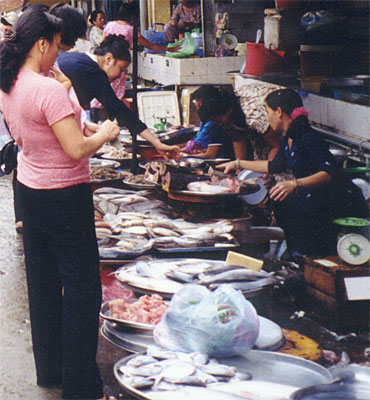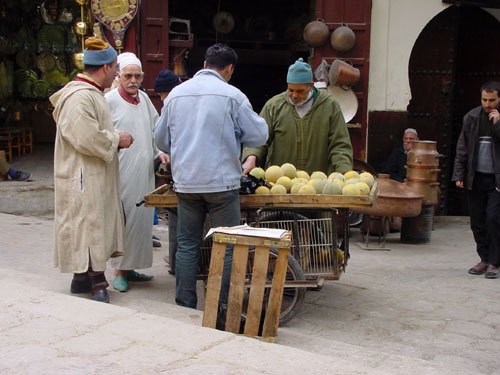Marketplace Bargaining / Haggling
Bob Ponterio
SUNY Cortland
In marketplaces around the world, in locations as distant as Mexico City, Haiti, Lima, Morocco, Hanoi, Shanghai, street vendors bargain over prices with their customers. We teach about this practice, sometimes even sending students into local markets with instructions to drive a hard bargain to practice their language skills, but what are the various perspectives that we should consider? What does bargaining mean? Why does it work? Who benefits?
Questions:
1. What are some typical characteristics of places where bargaining over prices is common?

Ecuador -
Pottery vendor
Glenn and Martha Vargas © California Academy of Sciences
|
Price flexibility means that the seller, often of very
modest means, can get the most from a day's work and be able to feed her
family. The buyer with little money can invest time to get an affordable
price and be able to feed her family. How much does driving a hard bargain
mean to the relatively affluent tourist? How much should it mean? How
do you know when to stop?
|
| |
2. Where is bargaining uncommon?
 |
Bargaining over prices predates fixed prices and even predates money. In today's economies, the less formal the setting, the more likely one is to bargain over prices. In department stores and chic boutiques that cater to the more affluent classes, prices tend to be fixed. In open air markets or on corners where street vendors make their living, haggling over prices is the norm. Low overhead, the difficulty and expense of carrying stock around or holding on to it too long, and the need to cater to a clientele of varying ability to afford a product leads to a need and an ability to vary prices and profit margin.
|
| Ho Chi Minh City : Photo Marie Ponterio |
3. How does bargaining fit into the social fabric of a society?
Produce is better sold at a loss than allowed to go
bad. In a market, the higher profit margins of the early morning can make
up for lower margins as the market is closing down and vendors seek to
get rid of unsold goods. Meanwhile customers network for access to information
about quality of goods and current prices. Such networks are important
community building structures. Marketplace networks of women have been
studied by ethnographers.
|

Ho Chi Minh City : Photo Marie Ponterio |
4. At the "retail" level, who bargains more? Who bargains less? Why?

Fez, Morocco : Photo, TravelAdventures.org |
In these informal settings, poorer customers may not
be prevented from purchasing goods because the price is not fixed by the
standard of what only the wealthy can afford. Wealthier customers save
time and get the best products by paying a higher price or by sending
someone to make the purchases for them. They recognize that a fair price
does not mean the same price for everyone.
|
5. What positive effects does bargaining bring to an economy?
Modernist western societies have often tried to close down street vendors whose low overhead and flexible pricing represent competition to larger, formal businesses such as supermarkets.
But street vendors can often make more than they could earn working for minimum wage at Wal-Mart, whose profits might not remain in the local economy. At the same time these vendors provide access to goods for those who can't afford to shop at the retail outlets. |
 |
Interesting site:
Mexican Street Vendors in Pictures - John Cross
© Bob Ponterio, 2005




